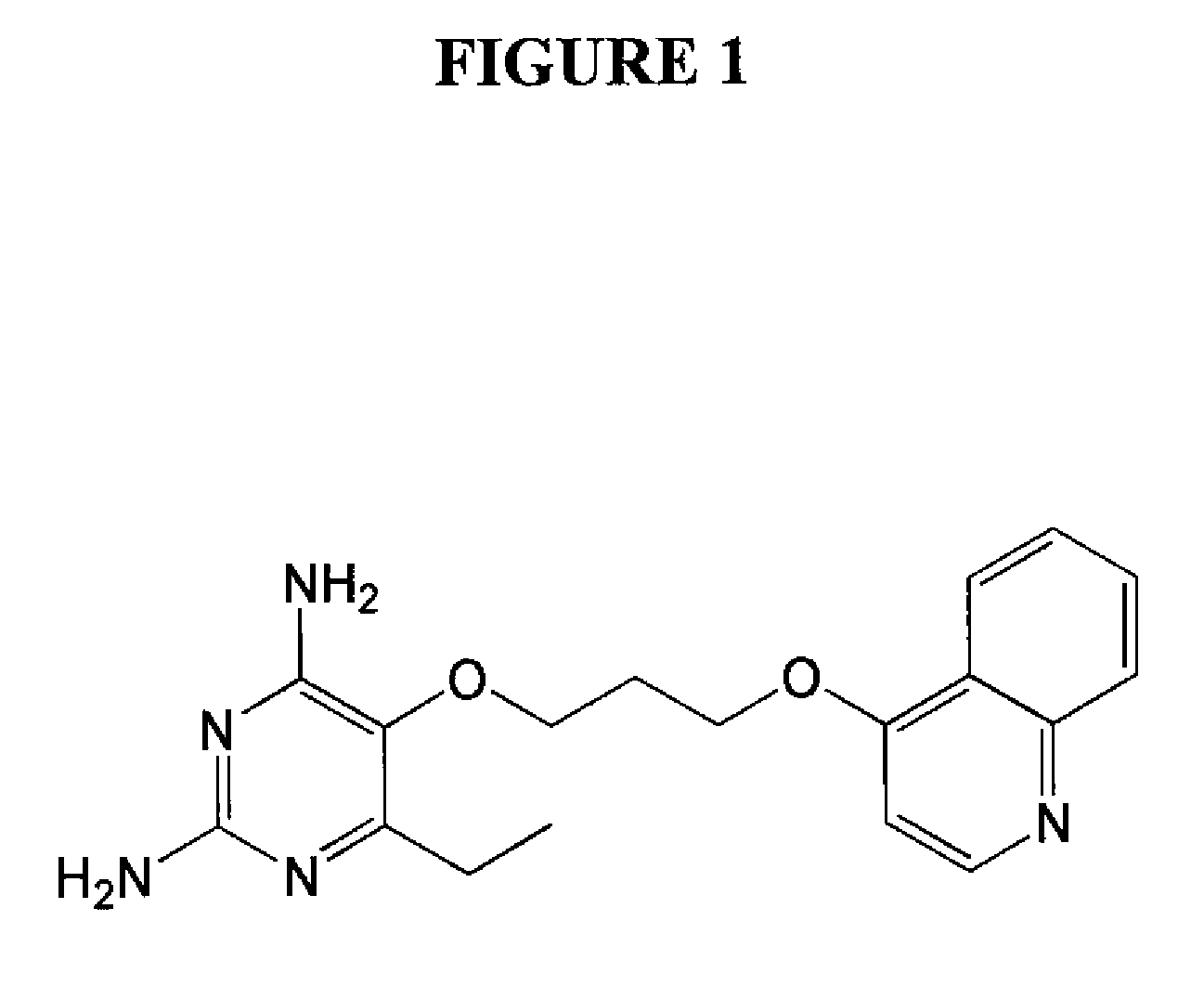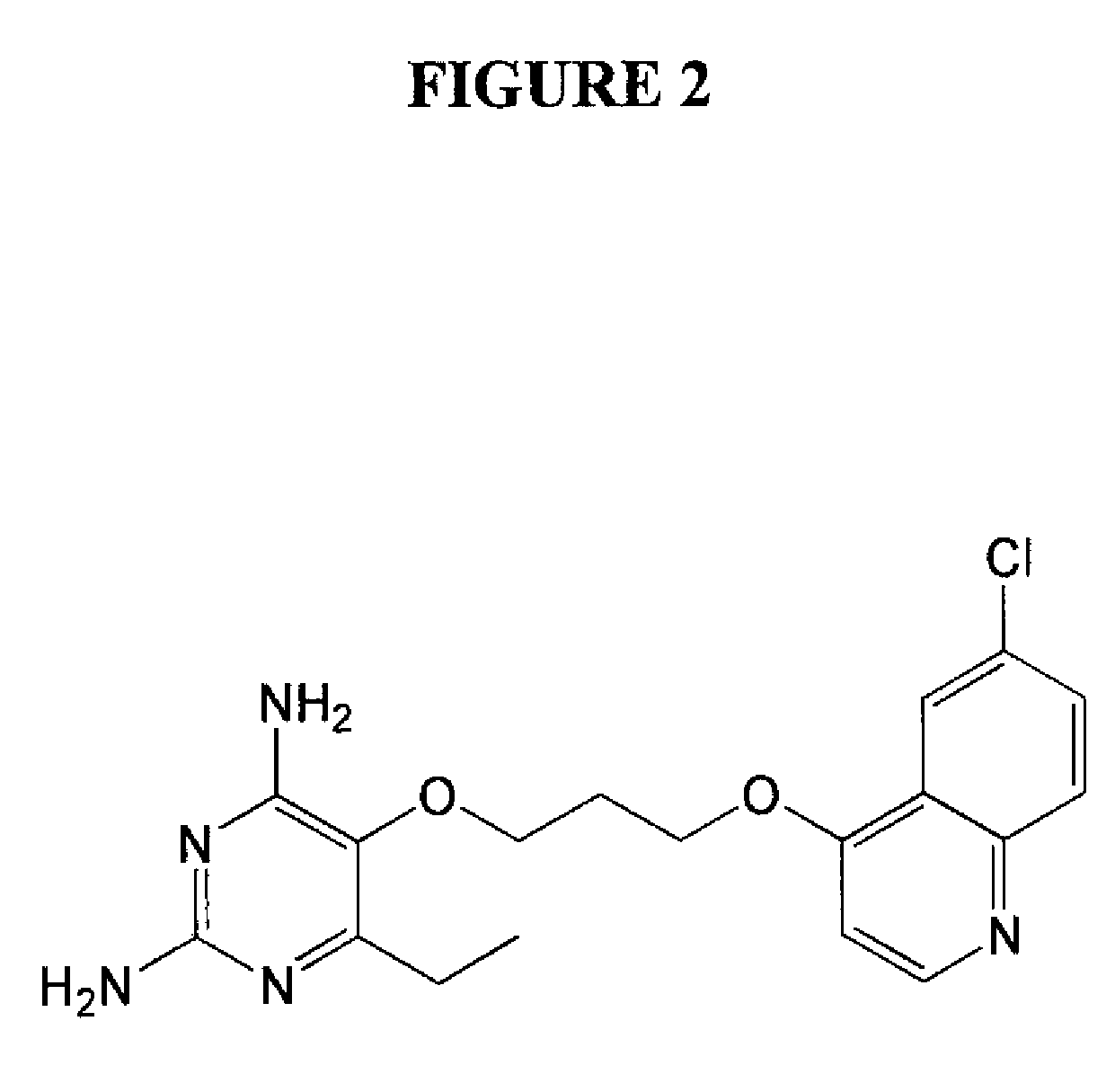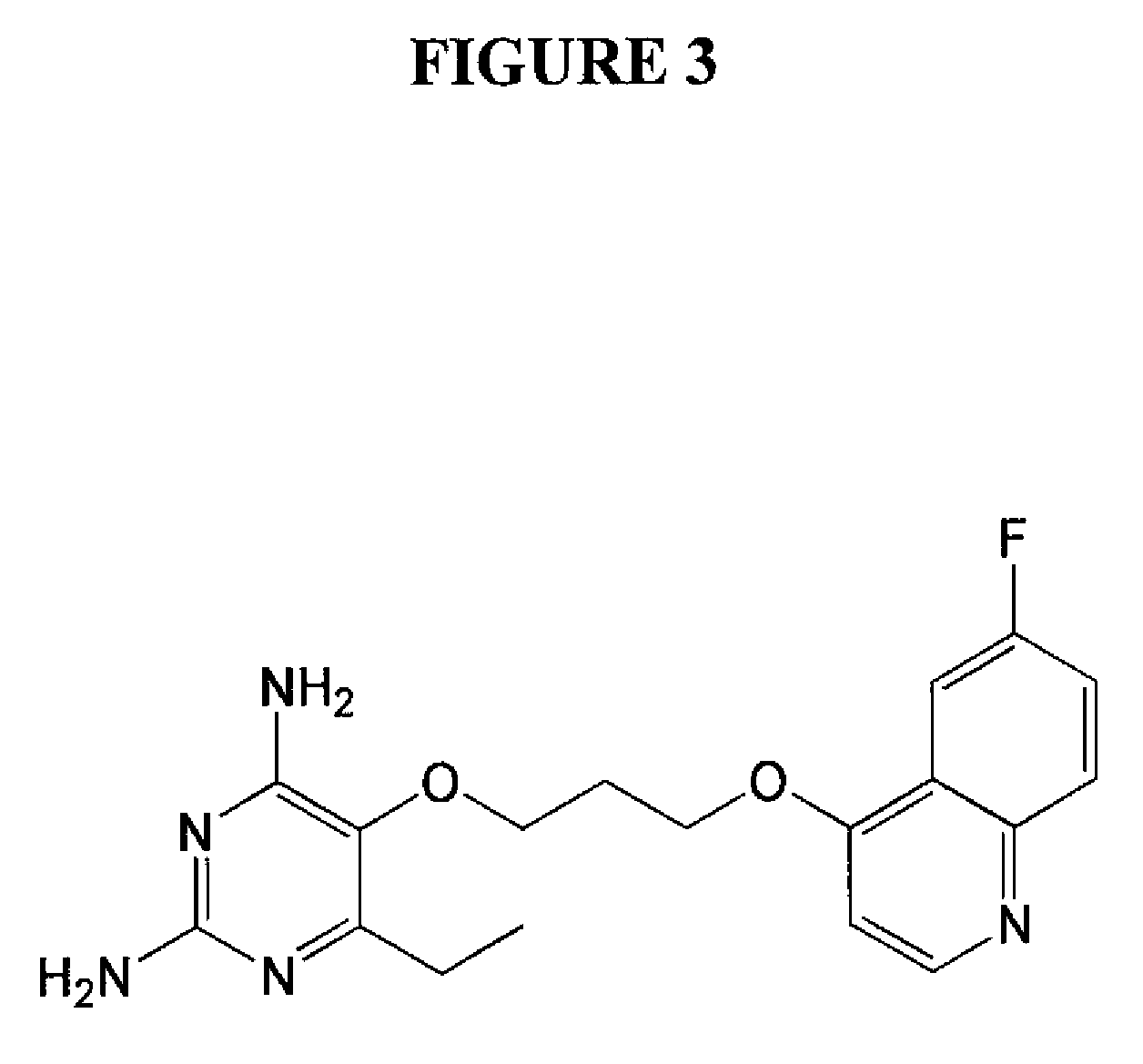Antimalarial compounds with flexible side-chains
a technology of side chains and compounds, applied in the field of antimalarial compounds or antifolates, can solve the problems of dangerous mans. p. falciparum, dangerous cell adhesion to the walls of blood, and dangerous
- Summary
- Abstract
- Description
- Claims
- Application Information
AI Technical Summary
Benefits of technology
Problems solved by technology
Method used
Image
Examples
example 1
2,4-diamino-6-ethyl-5-(3-(quinolin-4-yloxy)propoxy)pyrimidine (P113) (See FIG. 1)
[0069]A representative procedure for the preparation of 2,4-diamino-6-ethyl-5-(3-(quinolin-4-yloxy)propoxy)pyrimidine dihydrochloride is provided below:
a) 3-(quinolin-4-yloxy)propan-1-ol
[0070]A suspension of quinolin-4-ol (1.35 g, 9.30 mmol), anhydrous potassium carbonate (3.73 g, 26 mmol) and potassium iodide (4.23 g) in anhydrous DMF (8 mL) was stirred at 25° C. for 30 minutes. 3-Chloropropanol (2.93 g, 31 mmol) was added and the reaction was stirred until the starting material was consumed. The reaction was diluted with dichloromethane and extracted with water. The product was obtained as a slightly yellow solid (0.5298 g, 28%) after evaporation of the dichloromethane layer, and was used for the next step without further purification. 1H NMR (400 MHz, CDCl3): 2.09 (2H, m), 3.93 (2H, t, J=5.6 Hz), 4.10 (2H, t, J=5.6 Hz), 4.51 (11H, s), 6.25 (1H, d, J=5.5 Hz), 7.32 (1H, t, J=7.4 Hz), 7.56 (1H, t, J=8.2...
example 2
2,4-diamino-6-ethyl-5-(3-(6-chloro-quinolin-4-yloxy)propoxy)pyrimidine (P149) (See FIG. 2)
a) 6-Chloroquinolin-4-ol
[0075]A mixture of 2,2-dimethyl-1,3-dioxane-4,6-dione (Meldrum's acid, 21.62 g, 0.15 mol) and trimethyl orthoformate (150 mL) was heated to a gentle reflux under nitrogen for 1 hour. The resulting red solution was cooled (80° C.) and 4-chloroaniline (19.14 g, 0.15 mol) was added portionwise resulting in the formation of a yellow solid. The reaction mixture was heated to reflux, stirred vigorously for an additional hour, and then cooled to 25° C. (see Ryan et al. (2006) Org. Lett. 8:2779-2782; Madrid et al. (2005) Bioorg. Med. Chem. Lett. 15:1015-1018). The resulting solid was filtered and washed with cold acetone to afford the ene-amine compound (29.58 g, 70%, mp. 214-214.5° C. (dec.)) as yellow solid which was characterized by 1H NMR. To a solution diphenyl ether (20 mL) at 240° C. was added the ene-amine compound (5 g, 17.75 mmol) in small portions resulting in vigorou...
example 3
2,4-diamino-6-ethyl-5-(3-(6-fluoro-quinolin-4-yloxy)propoxy)pyrimidine (P153) (See FIG. 3)
a) 3-(6-fluoroquinolin-4-yloxy)propyl bromide hydrobromide
[0079]To a suspension solution of 6-fluoroquinolin-4-ol (3.67 g, 22.5 mmol) (synthesized in overall yield of 32% starting from 4-fluoroaniline and diethyl ethoxymethylenemalonate according to a literature procedure (see Price et al., Organic Syntheses, Coll. Vol. 3, p. 272; Vol. 28, p. 38), triphenylphosphine (6.56 g, 25 mmol), and 3-bromo-1-propanol (2.3 mL, 25 mmol) in dry tetrahydrofuran (30 mL) was added diisopropyl azodicarboxylate (4.9 mL, 25 mmol) at 25° C. over 30 minutes under nitrogen and the reaction mixture was left stirring for one hour. Hydrobromic acid (2.8 mL of 48% aqueous solution, 25 mmol) was added, resulting in precipitation of the titled compound. The product was collected by suction filtration and washed with THF, acetone and ether to give a light yellow crystalline solid (4.17 g, 51%). 1H NMR (400 MHz, DMSO-d6): 2...
PUM
| Property | Measurement | Unit |
|---|---|---|
| Electrical resistance | aaaaa | aaaaa |
Abstract
Description
Claims
Application Information
 Login to View More
Login to View More - R&D
- Intellectual Property
- Life Sciences
- Materials
- Tech Scout
- Unparalleled Data Quality
- Higher Quality Content
- 60% Fewer Hallucinations
Browse by: Latest US Patents, China's latest patents, Technical Efficacy Thesaurus, Application Domain, Technology Topic, Popular Technical Reports.
© 2025 PatSnap. All rights reserved.Legal|Privacy policy|Modern Slavery Act Transparency Statement|Sitemap|About US| Contact US: help@patsnap.com



